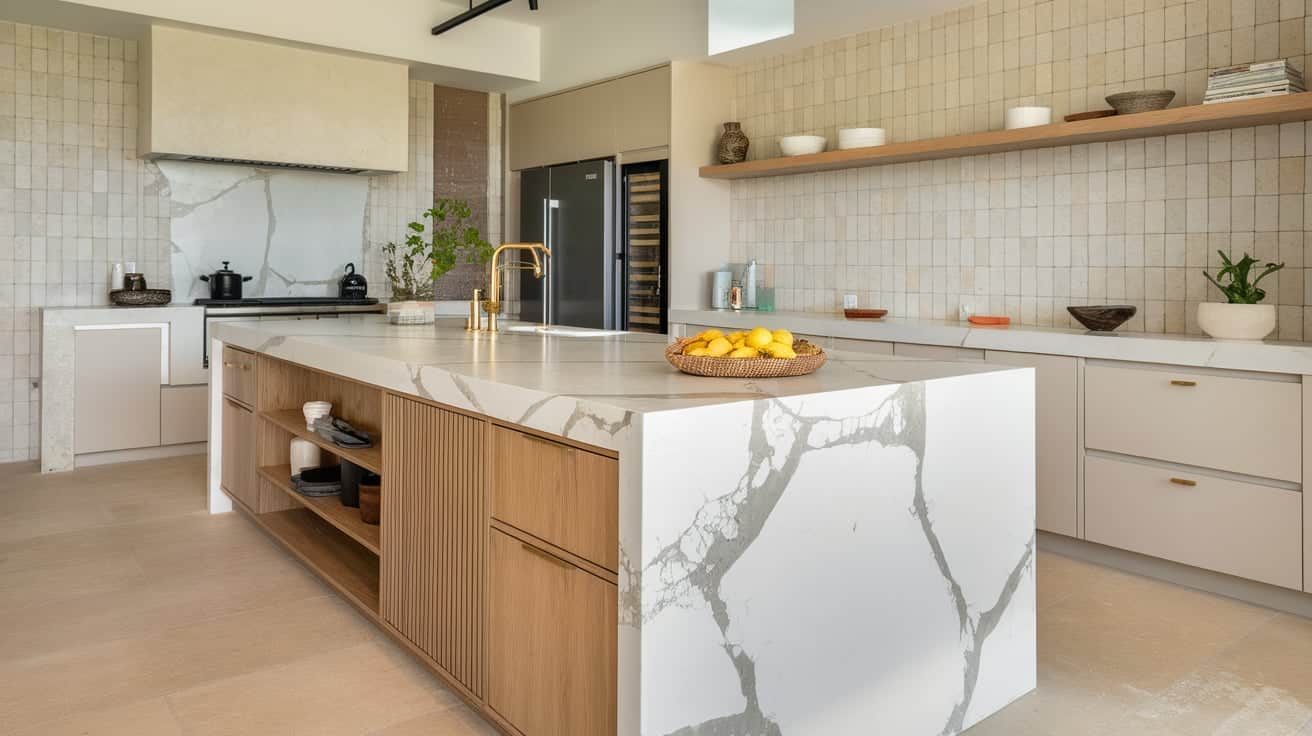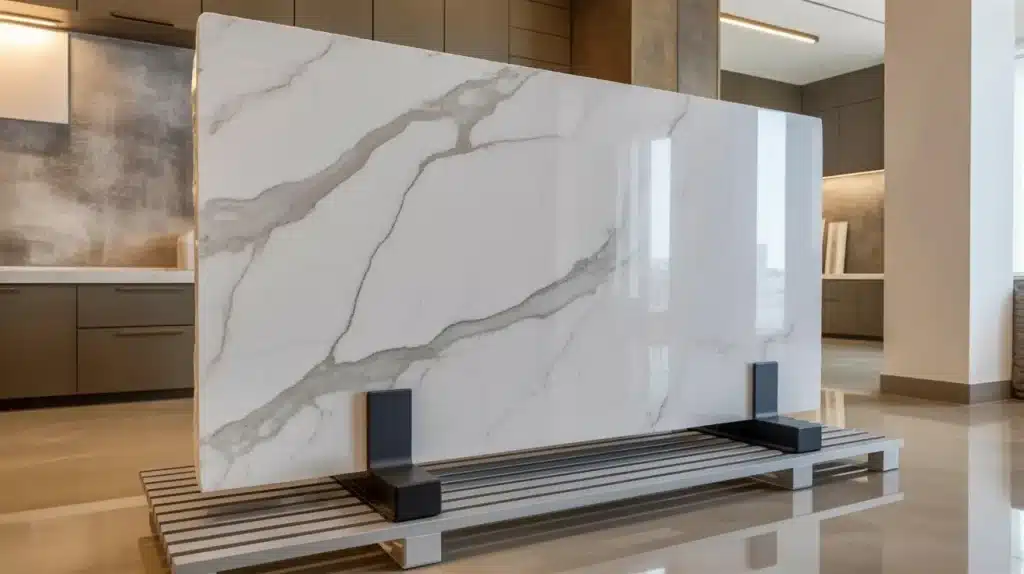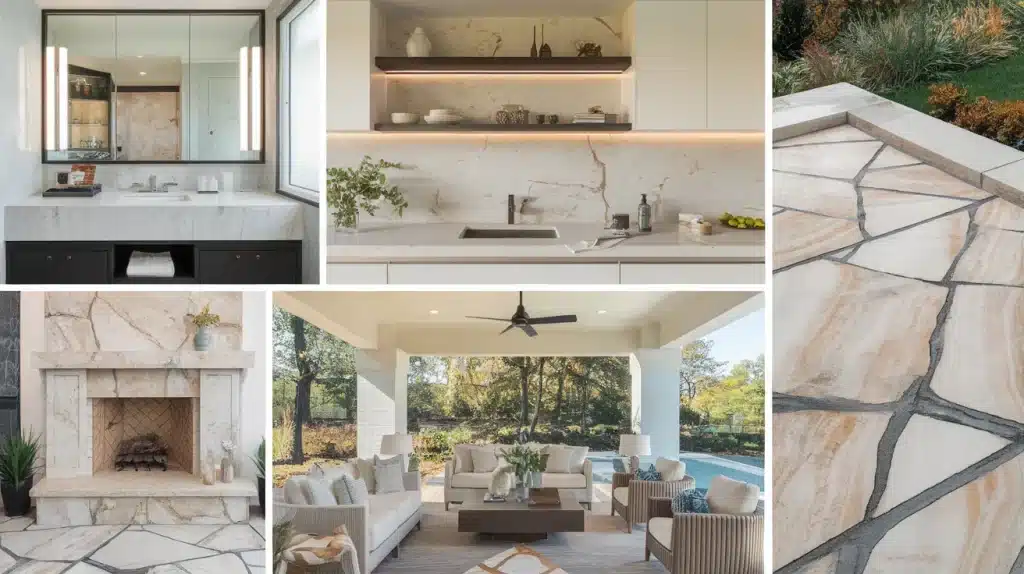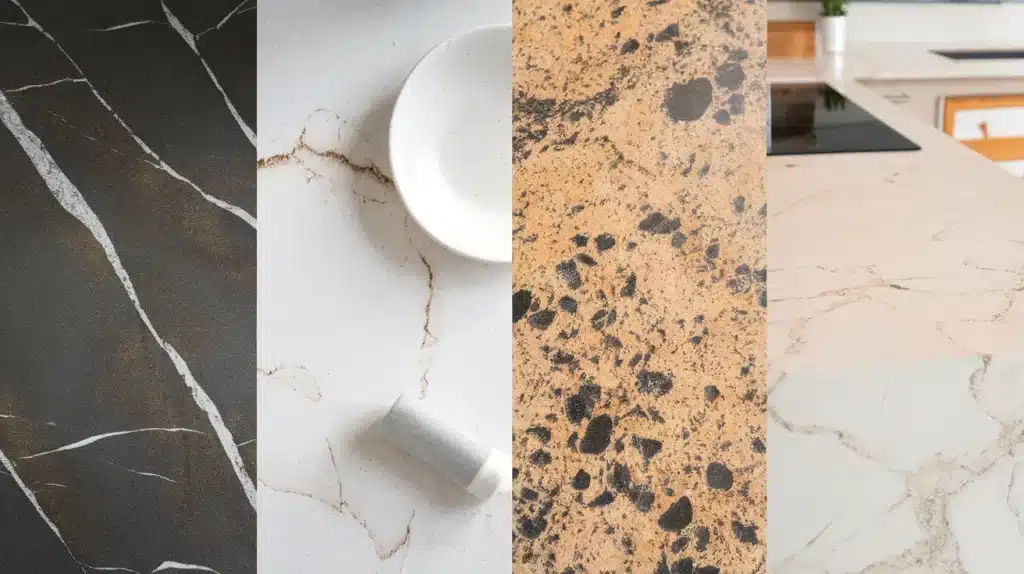Looking for a countertop material that can handle hot pots, resist stains, and never need sealing? Sintered stone might be your answer.
This high-tech surface material is gaining popularity in premium kitchens and outdoor spaces nationwide. Made from compressed natural minerals under extreme heat and pressure, sintered stone offers the beauty of marble with the strength of engineered materials.
It’s tougher than granite, more heat-resistant than quartz, and requires almost zero maintenance. But is it worth the higher price tag?
In this guide, we’ll break down everything you need to know about sintered stone countertops, from their manufacturing process to determining if they’re the right choice for your home.
Let’s examine why designers and homeowners are choosing this modern material over traditional options.
What Is Sintered Stone?
Sintered stone is a manufactured surface material made by compressing natural minerals, feldspar, silica, and metal oxides under extreme heat (over 2000°F) and pressure.
This process fuses the raw materials without melting them, creating a dense, non-porous slab that’s harder than granite. Unlike natural stone, which forms over thousands of years, sintered stone is made in just hours under controlled factory conditions.
It also differs from engineered stone because it contains no resins or binding agents; instead, it is composed of compressed natural materials that bond through heat and pressure alone.
How Sintered Stone Is Made?
The manufacturing process begins with the selection of premium natural minerals, including quartz, feldspar, and clay. These raw materials are mixed in precise ratios and placed into molds.
The mixture then undergoes compression at 5,900 tons of pressure while being heated to temperatures exceeding 2,000°F (1,100 °C). This extreme heat and pressure fuse the particles without the use of any chemical binders.
Leading brands like Neolith use their TSP (Technology of Sintered Particles) process, while Dekton by Cosentino employs their exclusive Sinterized Particle Technology. The entire cycle takes about 4 hours, resulting in slabs that are incredibly dense and uniform.
Sintered Stone Cost Breakdown
Understand the key factors that influence sintered stone countertop pricing from brand and thickness to installation complexity so you can budget smartly for your space.
| Item | Details |
|---|---|
| Price Range | $60 – $120 per sq. ft. (installed) |
| Top Brands | Neolith, Dekton, Lapitec (premium pricing) |
| Thickness Impact | Thicker slabs (12–20mm) cost more than thin ones |
| Finish & Edges | Textured finishes and custom edges add cost |
| Installation Factors | Complex layouts, outdoor use, and skilled labor raise the price |
| Location | Prices vary by region and availability |
Benefits of Sintered Stone as a Countertop Material
Sintered stone countertops offer a powerful combination of durability, heat resistance, and low maintenance, making them a top choice for modern kitchens and high-performance surfaces.
1. Durability
Sintered stone ranks 6-7 on the Mohs hardness scale, making it more challenging than granite. You can chop vegetables directly on the surface without worrying about scratches.
The material won’t crack under everyday kitchen use or heavy impacts. Its compressed structure makes it three times stronger than natural stone.
2. Heat Resistance
Place hot pots and pans directly from the stove onto sintered stone without risk of damage. The surface can withstand temperatures up to 2000°F without discoloration or cracking.
No need for trivets or hot pads during cooking. This makes it ideal for busy kitchens where accidents are likely to occur.
3. Stain & UV Resistance
Spilled wine, coffee, or oil won’t penetrate the non-porous surface. The material maintains its color even under direct sunlight for years. This makes it ideal for outdoor kitchens and bright, sunny rooms, with no yellowing or fading like other countertop materials.
4. Low Maintenance
Daily cleaning requires only soap and water – no special cleaners needed. The surface never requires sealing or polishing, unlike natural stone. Bacteria and mold can’t grow on a non-porous surface. This saves time and money on maintenance costs.
5. Visual Versatility
Sintered stone perfectly mimics the veining of marble, the grain of wood, or the texture of concrete. Select from matte, polished, or textured finishes to complement your style.
Available in thin 6mm slabs or thick 20mm options. The design possibilities are virtually limitless for any home decor.
Drawbacks and Limitations of Sintered Stone
- Brittleness: Thin slabs can chip or crack during transportation and installation if not handled with care.
- Higher Cost: Expect to pay 20-30% more than quartz and significantly more than laminate countertops.
- Limited Edge Options: Most fabricators can only offer straight or slightly rounded edges, not complex profiles.
- Fewer Qualified Installers: Many countertop fabricators lack experience with sintered stone cutting and installation techniques.
Where and How to Use Sintered Stone
1. Ideal Applications
Sintered stone works perfectly for kitchen countertops, bathroom vanities, backsplashes, shower walls, and flooring throughout your home.
It’s also excellent for fireplace surrounds, dining tables, and accent walls. The material can be used for both horizontal and vertical surfaces without structural concerns.
2. Indoor vs Outdoor Suitability
The material excels both indoors and outdoors, and can be used for outdoor kitchens, pool areas, and patio surfaces without worrying about weather damage.
UV rays won’t fade the colors, and freeze-thaw cycles won’t cause cracking. Rain, snow, and direct sunlight do not affect the surface integrity.
3. Design Style Compatibility
Sintered stone fits modern, contemporary, minimalist, and industrial design styles, with options that also complement traditional and transitional spaces.
Choose marble-look patterns for classic kitchens, concrete textures for industrial lofts, or wood-grain finishes for warm, natural designs. The large-format slabs create fewer seams, providing clean, uninterrupted surfaces that make any space appear more luxurious.
Best Brands Offering Sintered Stone Countertops
- Neolith: Pioneered TSP (Technology of Sintered Particles) and offers the broadest range of large-format slabs up to 10 feet.
- Dekton by Cosentino: utilizes exclusive Sinterized Particle Technology, providing the most heat-resistant surface on the market.
- Lapitec: Specializes in full-body coloration technology, ensuring consistent color throughout the entire slab thickness.
- Laminam: Known for ultra-thin 3mm slabs and lightweight options perfect for wall applications and furniture.
Sintered Stone vs Other Countertop Materials
| Feature | Sintered Stone | Quartz | Granite | Porcelain |
|---|---|---|---|---|
| Durability | Excellent (resists heat, scratches, UV) | Durable, but heat-sensitive | Very strong, can chip, needs sealing | Excellent (resists heat and scratches) |
| Maintenance | Low (non-porous, no sealing) | Low | Moderate (requires sealing) | Very low |
| Appearance | Mimics natural stone, sleek finishes | Consistent patterns, modern look | Natural beauty, unique veining | Clean, minimal, contemporary look |
| Heat Resistance | Outstanding | Weak | Good | Outstanding |
| Outdoor Use | Ideal for outdoor applications | Not recommended | Limited suitability | Ideal for outdoor and vertical use |
| Best For | High-end, modern, indoor/outdoor surfaces | Budget-friendly, indoor kitchens | Traditional, natural stone kitchens | Minimalist, outdoor, wall cladding |
| Main Drawback | Higher cost, requires skilled installers | Prone to heat damage | Needs ongoing maintenance | Can chip at edges, fewer fabricators |
Should You Choose Sintered Stone Countertops?
If you value extreme durability, modern looks, low maintenance, and indoor-outdoor flexibility, and are willing to invest in quality sintered stone, it is an excellent choice.
It’s ideal for premium kitchens, outdoor areas, and sleek, contemporary spaces where both performance and style are paramount. The material is best suited for homeowners who want a surface that can withstand heavy use without requiring constant upkeep.
However, if budget is your primary concern or you prefer traditional stone looks, quartz or granite might be better options for your home.
Final Thoughts
Sintered stone countertops represent a wise investment for homeowners who want performance without compromise.
This material delivers on its promises of extreme durability, heat resistance, and virtually zero maintenance requirements.
While the upfront cost is higher than that of quartz or granite, you’ll save money over time, as no sealing, polishing, or repairs are needed.
The technology behind sintered stone creates a surface that’s ready for whatever your kitchen can throw at it. From busy family meals to entertaining guests, it handles everything with style.
If you’re planning a kitchen renovation or building a new home, sintered stone is a material that deserves serious consideration.
The combination of modern manufacturing and natural materials creates something truly special, a countertop that works as hard as you do, while looking great for years to come.
Frequently Asked Questions
What Is the Downside of Sintered Stone?
The main downsides are higher cost than quartz, potential brittleness in thin slabs, and fewer experienced installers available.
Which Is Better, Quartz or Sintered Stone?
Sintered stone is better for heat resistance and outdoor use, while quartz offers more edge options and lower cost.
Can you Put a Hot Pan on a Sintered Stone?
Yes, you can place hot pots and pans directly on sintered stone without any damage or discoloration.
Why Is Sintered Stone Banned?
Sintered stone is not banned; this is a misconception. It’s fully approved for residential and commercial use worldwide.











